Caries (cavities) can occur in any breed of dog, but medium to large breeds are more affected (Hernandez et al, 2019). Lesions can occur on any tooth, although occlusal (grinding) surfaces seem to be predisposed, namely the first maxillary molar teeth, because of the close interproximal contact. Figure 1 shows the structure of the dog’s tooth. Clinically, caries manifest as softened or often discoloured spots in the enamel and a dental explorer will catch on the softened carious lesion, although root caries have also been identified (Lobrise, 2019). Caries is not clinically relevant in cats. While uncommon, caries require knowledge and understanding of the pathogenesis, so that the veterinary team is best prepared to give accurate diagnosis and allow the client to make informed decisions regarding the treatment process for their pet. Veterinary nurses can aid the diagnosis via thorough dental examination, knowledge of aetiology, progression of the disease, diagnostic imaging, treatment options and prevention methods.
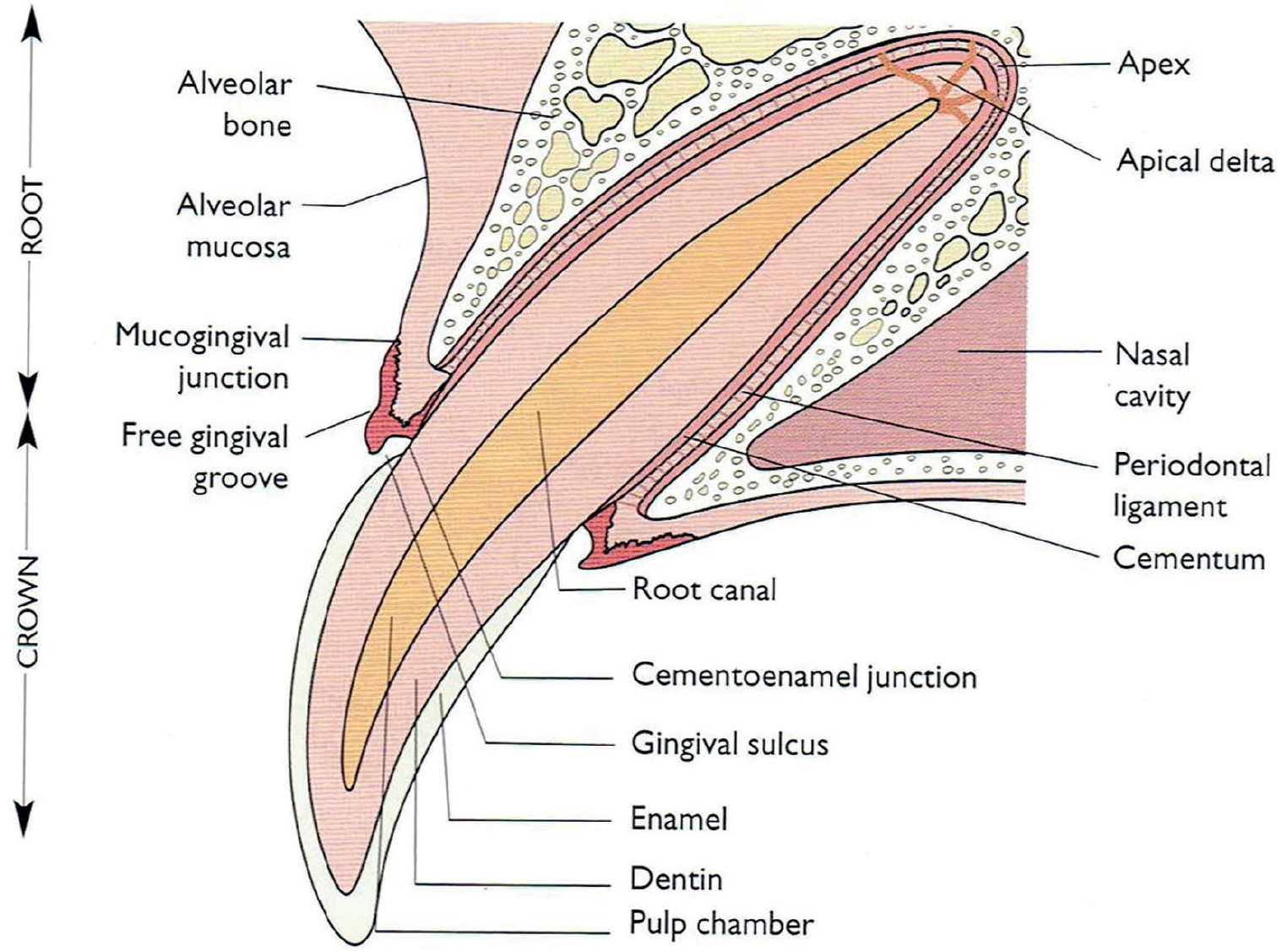
While both caries and periodontal disease are caused by an accumulation of plaque bacteria on the tooth surface, the pathogenesis of the two diseases is completely different. Teeth are composed of three hard tissues - enamel, cementum and dentine - and a pulp cavity. Dentine is a complex matrix of initial non-mineralised collagen that lines the inner pulp portion of the tooth as primary dentine. Synthesis by odontoblasts and the incorporation of non-collagenous proteins, such as glycoproteins, to form secondary dentine in its maturation. Plaque biofilms formed by aerobic and anaerobic microorganisms adhere to the tooth surface and over time develop the perfect environment necessary to thrive and survive. Over time plaque mineralises, forming dental calculus. While microorganisms in calculus show no signs of metabolic activity, it serves as a substrate for deposition of new plaque. The only way to stop this process is via mechanical removal of the oral biofilm by toothbrushing or by regular professional descale and polish (Assunção et al, 2021).
Pathogenesis of caries
Caries (Figure 2) form as a result of a process called ‘inorganic demineralisation’ of the enamel caused by the fermentation of plaque bacteria within the oral cavity. These bacteria use the carbohydrate (sugars) in food as a source of energy. The fermentation is acidic in nature, which causes demineralisation of the hard surfaces of the tooth structure and thus allows bacteria to infiltrate into the dentine. Once in the dentine the process accelerates as ‘organic decay’. This may eventually extend to the pulp, causing pulpitis and pulp necrosis and/or periapical pathology.
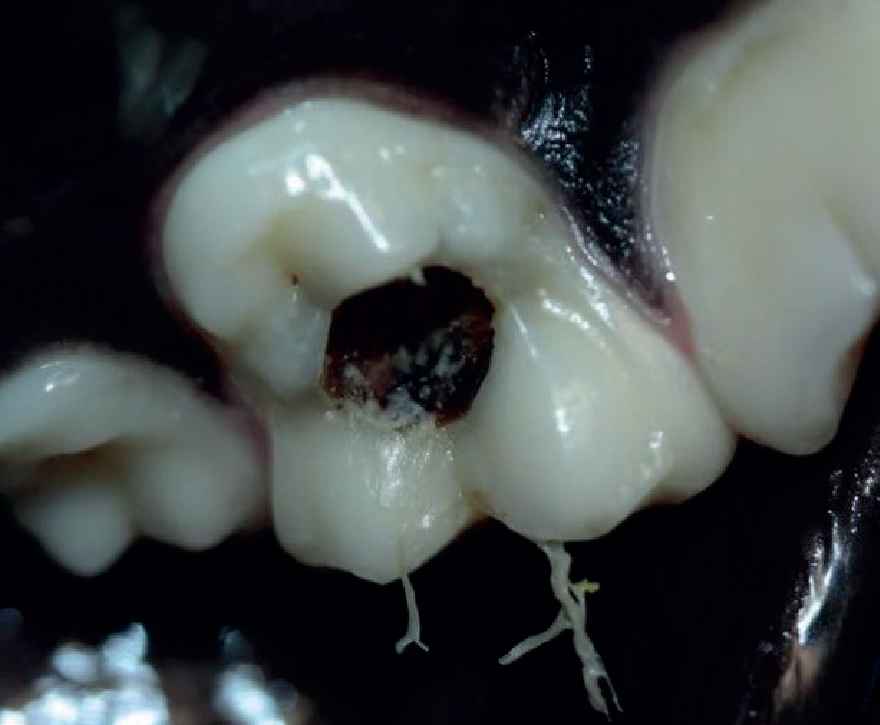
Dental caries stimulate the formation of reparative or tertiary dentine on the pulpal wall directly beneath it. Depending on the progression of fermentation, the deposition of tertiary dentine may prevent exposure of the dental pulp, but if the decay progresses faster than the tertiary dentine there will be pulp exposure within the cavity (Figures 3 and 4 ) (Gorrel and Derbyshire, 2005). It is also important to understand that tooth erosion is not the same as caries - tooth erosion occurs as a result of external acids causing demineralisation of the tooth surface and is rarely seen within the tooth. This differentiates whether the diagnosis is caries (lesion within the tooth) or tooth erosion (lesion affecting the outer surface of the tooth) (Reiter, 2019).
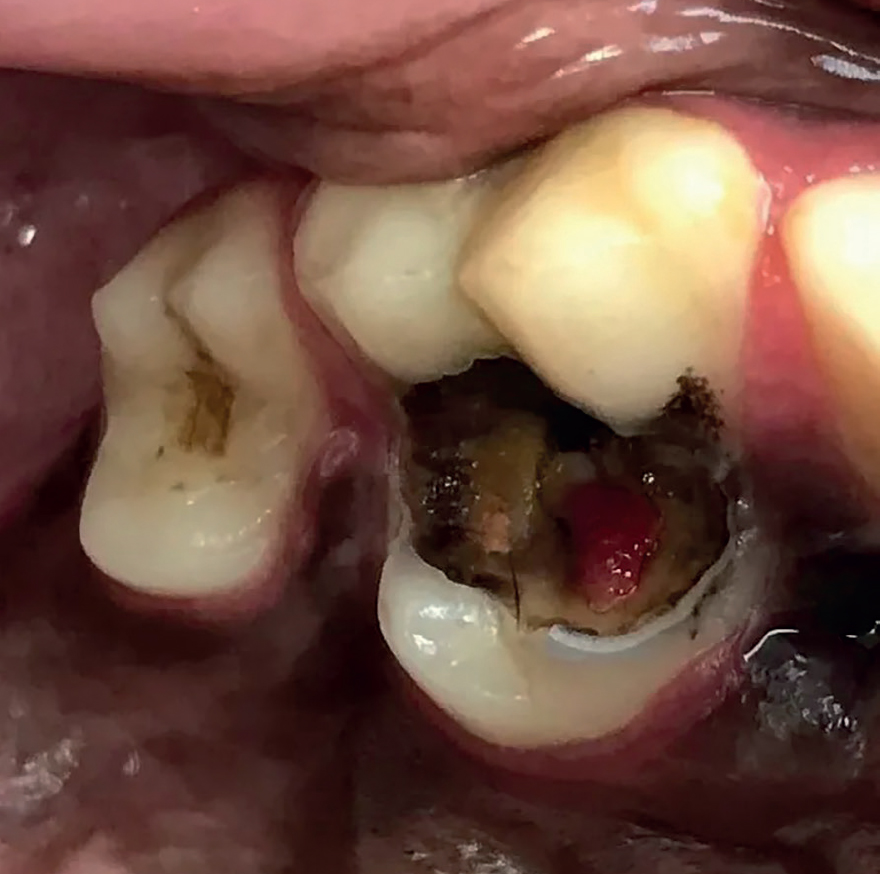
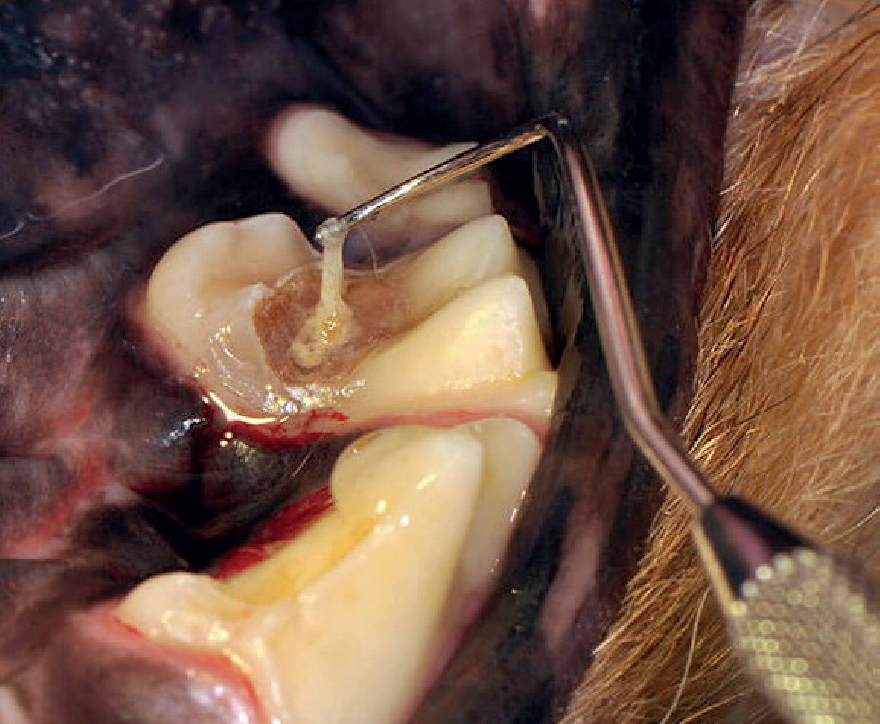
Pathogenesis of periodontal disease
Periodontal disease is a plaque-induced inflammation of the functioning space of the periodontium - this space comprises gingiva, periodontal ligament, alveolar bone and cementum. Periodontal disease is caused by an aerobic bacterial infiltration into the periodontal space which in turn creates an anaerobic (oxygen-free) environment for bacteria to multiply. Aerobic cocci and rods penetrate the space and grow in the anoxic and nutrient-rich environment formed by the glycoprotein layer of the pellicle. With continued plaque maturation and the inflammatory response of the host, this provides the optimum environment for periodontitis to develop (Wallis and Holcombe, 2020).
Diagnosis
Upon examination a small enamel defect may be noted. If the defect is probed and a carious lesion suspected there may be a large cavern of decayed dentine below the surface (Figure 4). A chalky white substance known as incipient caries is the first indication of enamel demineralisation. Not all lesions are grossly discoloured, and all occlusal surfaces should be meticulously examined with a dental explorer (Figure 4). If the explorer sticks in the tooth surface, then caries should be suspected, and radiographs are indicated.
Radiographically, radiolucent defects are seen on the affected area of the crown (Figure 5). Radiographs will also give an indication of how close to the pulp chamber a lesion may extend, which allows appropriate selection of treatment.
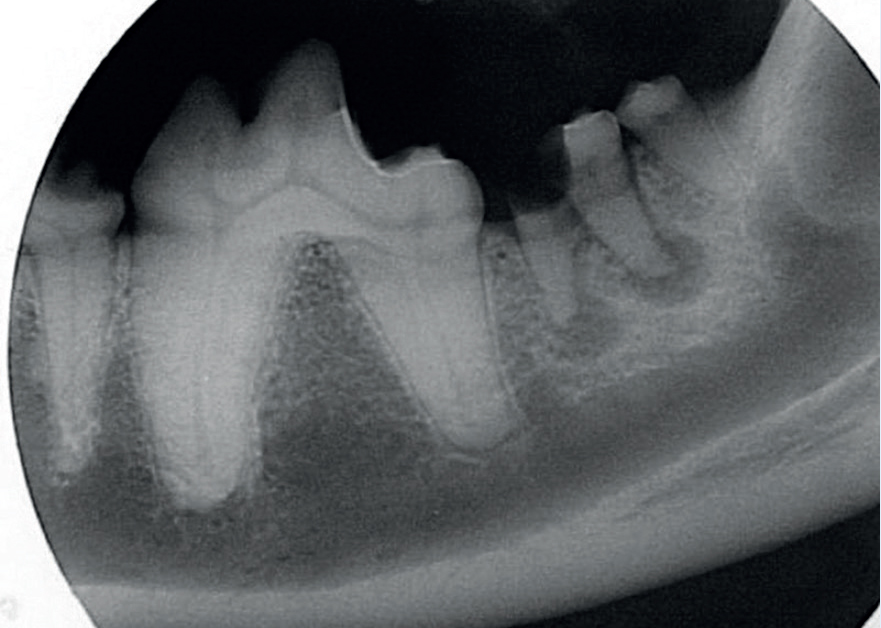
A dental mirror can be useful as an indirect visual aid redirecting light to an area of interest, as well as being used as a soft tissue retractor to help with visualisation. Histopathological examination of any removed teeth is also crucial in the accurate assessment and overall diagnosis of a dental lesion, as diagnosis can only be confirmed with microscopy. This is impossible with teeth still left in situ, but must be considered where extractions are indicated.
Treatment
Diagnosed caries require treatment. The only viable options (depending on severity) are extraction of the affected tooth/teeth or referral for restorative treatment. If the process has already resulted in gross loss of the tooth surface at the time of diagnosis, then extraction is the only viable option (Caiafa and Visser, 2019).
Treatment is mandatory after diagnosis as caries are very rarely diagnosed at the early stage of enamel demineralisation. Treatment by restoration should only be carried out by trained professionals and usually requires referral to a specialist dental/oral surgeon. It must never be attempted by anyone without the correct skillset. There is the risk of trapping cariogenic bacteria under the restoration if not thoroughly disinfected, so practitioners must work within their scope of competencies with these cases and be transparent with clients to allow them to make informed consent and decisions regarding their pet. Treatment options must always be discussed within the team for the best possible outcome for any patient under a veterinary surgeon’s care. While ultimately the decision making and diagnosis is done by the veterinary surgeon, veterinary nurses play a key part in their knowledge of cases, knowing their patient and helping to manage client expectations.
Prevention
The initial inorganic demineralisation can be stopped if the process has not reached the enamel-dentine junction. Meticulous dental hygiene in combination with topical gingival or enamel sealant treatments and dietary restrictions can lead to remineralisation of the initial defect. However, if the process has entered the dentine, it becomes irreversible and progressive. Measures to prevent new lesions forming must be instituted in animals with diagnosed caries.
In addition to homecare and dietary modifications, these dogs may benefit from subsequent regular professional descaling and application of dental sealants. Enamel and gingival sealants enhance the remineralisation process and makes enamel more resistant to the acid dissolution that occurs with caries. An extensive range of oral hygiene prevention products can be explored via the Veterinary Oral Health Council website (Veterinary Oral Health Council, 2022). As always, prevention is better than cure.
The veterinary nurse’s role
Client education is key with any form of dental or oral pathology and in the case of caries management this involves making sure that patients are on a suitable diet from a young age and that clients are taught how to brush their pet’s teeth. Nurse clinics are a useful tool in engaging with puppies and getting them used to having their mouths opened and examined on a regular basis. This will make the puppy less likely to become head shy. Starting tooth brushing at a young age and allowing the puppy to engage in a fun activity helps with client-patient bonding and the patient must always be rewarded for their efforts. Early toothbrushing is important to help provide the mechanical action of plaque removal, much the same as tooth brushing in humans. Oral hygiene is paramount, not only to help prevent the development of caries, but a plethora of many other oral diseases. It also allows the owner to understand normal oral pathology so they can quickly see abnormalities that may have otherwise gone undetected.
The veterinary nurse’s role in the control of bacteraemia is very important. Every tooth is covered by an acellular membrane known as a pellicle and plaque sticks to this surface creating a biofilm of bacteria. Antibiotics do not have an effect on bacteria in biofilms, so antibiotics should be used sparingly and only in cases where a patient has a clinical presentation of a bacterial infection (these cases should be discussed with the veterinary surgeon). Antibiotic resistance is a real threat (NOAH, 2016), so part of the veterinary nurse’s role is to avoid their use as much as possible by helping to prevent the progression of such diseases. Plaque does not form as a result of food passing through the oral cavity, rather the biofilm appears as soon as toothbrushing has stopped as the mouth has all the components required (saliva, gingival crevicular and bacteria) to aid the accumulation on tooth surfaces.
Dry kibble diets should be promoted over wet or moist foods where possible, as sticky carbohydrate-rich foods help to speed up the process of plaque accumulation. The introduction of a dental-specific diet for a patient aims to prevent and remove small amounts of plaque and calculus, and should be used as a multi-modal approach to plaque removal from the teeth.
Diets which are high in fibre have been shown to reduce plaque and calculus formation, as have diets with enough protein (Jank, 2021). Adequately balanced nutrition reduces the amount of oral disease by helping to lower the risk of mineralisation of plaque into calculus and supporting the overall structures within the oral cavity (Ackerman, 2012).
Conclusions
While caries are rare, a good understanding of their formation and progression is key to prevention. Veterinary nurses have the skillset to educate clients on the plethora of oral conditions dogs may face. The key to prevention is early intervention, so using nurse clinics is a must. Even if the nurse does not have an extensive knowledge of oral disease pathologies, solid basic understanding goes a long way along with instigating toothbrushing and dietary clinics as a critical step in client bonding to practice, patient care and wellbeing. Visual aids and models can help educate owners on their pet’s oral anatomy and help engage them in consults so they may best help their pet at home.
Key Points
- Daily toothbrushing can reduce levels of plaque in the oral cavity.
- Daily toothbrushing should be performed alongside the use of adjunct products such as diet and dental chews.
- Client compliance can be improved by providing education in practice and understanding client limitations.
- Caries prevention can be encouraged through education on diets and oral homecare techniques to help to reduce levels of bacteria and plaque formation.


